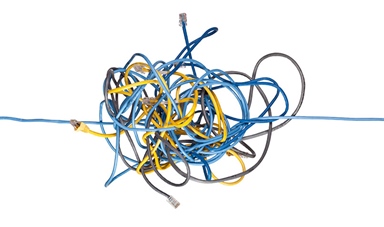Loading component...
At a glance
By Linda Moon
In Digital Minimalism, Cal Newport warns our reckless and ubiquitous uptake of tech is leading us into “lives of quiet desperation”. It is an opinion that echoes the long spoken words of Western philosopher Henry Thoreau, who died in 1862.
Unwittingly, we have forfeited life’s meaningful elements to manage a surfeit of virtual information. Newport found people felt exhausted and controlled by the sum of their tech baubles.
Damian Madden, a technology executive with more than 20 years’ experience, says: “We’ve tricked ourselves into thinking it’s all about efficiency and connection. It’s the opposite”.
One global study found information workers spent two hours a week uselessly searching for lost digital documents.
The impact of digital clutter
Digital clutter is having excessive digital files in a state of disarray.
Dr Micheal Axelsen, a senior lecturer in business information systems at the University of Queensland Business School and a former Fellow of CPA Australia, says the biggest cost is sifting through irrelevant files to find what we need.
According to UK research, hoarding data impairs productivity and causes stress, anxiety and disorganisation.
It also increases the risk of our data leaking into the wrong hands. Little bits of personal, identifying information (stored on our devices, linked to apps and online accounts) are a potential goldmine for cybercriminals and marketers, Axelsen explains.
Digital minimalism, a philosophy that “less is more” in relation to tech, can help us regain control. Here are nine steps towards a more harmonious online existence.
1. Delete unnecessary apps and programs
Also be selective about those you download – deleting an app doesn’t necessarily remove your data from the provider’s server, Axelsen reveals.
For apps you’re no longer using, it’s also important to go to wherever the authentication (for login) has been and disable that back door into those accounts. “Until you unauthorise them, they will still have access to your Facebook stuff, whatever you agreed to give to them in the first place,” he says.
2. Trim the fat
Rich media files like video, images and audio, chew up the most space, Axelsen says.
Do a search on your computer to locate files by size. Erase those you don’t need.
3. Hunt out the duplicates
Duplicates occur from storing things in multiple places. Often it’s just a facet of how our devices work. “Our systems are built on multiple redundancies all over the place,” Axelsen says.
“It’s time consuming to work out what is a duplicate. The other danger is, I might use an old version of something if I haven’t been using version control.”
Backup files, another source of clutter, are often hidden deep in our computer, particularly in Mac’s Library applications settings, he reveals. “In Windows, sometimes it’s in the Windows directory.”
Tools such as CCleaner (built into Windows), or Gemini (for Mac) can identify duplicates, Axelsen says.
4. Clear downloads
The Downloads directory is a common spot for duplicates and unwanted items.
“Make sure downloads are happening in that directory so that you can clean them out,” Axelsen advises.
Make culling easier by immediately moving anything you want to keep out of the Downloads directory, he suggests.
5. Give it a spot
Metaphorically speaking, our virtual items shouldn’t be scattered across the bedroom, lounge and kitchen, he says.
Make sure everything you want to keep has a place to go, Axelsen says.
6. Systemise photos
Madden says the digital age causes many of us to take way too many photos: “So many photos are essentially the same photo,” he says. Along with deleting the duds, Madden suggests being selective about what you upload from your camera or device.
Having trouble finding a particular photo? It’s likely your filing system isn’t working.
“People tend to group them by date. That doesn’t work,” Madden says. He recommends filing photos by occasions, creating sub-folders of favourites and only backing those up.
7. Tame your email
Email is one of our biggest digital stresses, Axelsen says.
Firstly, reduce those you get. Unsubscribe and tag nuisance email as “junk”. Artificial intelligence tools can help you sort emails quicker.
Detaching attachments enables you to cull more emails, Axelsen says. “You can spend so much of your day just dealing with email. You’ve got to become as efficient at that as you can.”
Madden thinks people place undue importance on emails. He separates his into just three folders – Doing, Reading and Archives with sub-folders in his Archives.
Axelsen reduces his emails further by using the phone, and threaded chats on Slack and Teams.
He suggests using Dropbox or OneDrive to send large files. “Copy a link to it into your email, so your email is much smaller. The other thing is it gets updated in the one spot.”
8. Work minimally
Disable annoying alerts and notifications using the Settings on your devices and social media accounts.
Avoid working with too much open at once. Save anything interesting somewhere specific.
Staying logged into accounts like Facebook and Google (or apps using their logins) also means your searches are being harvested, Axelsen warns.
9. Archive strategically
Multiple backups are another source of digital glut. Have a dedicated system of archiving and date everything.
Keep backups separate from your working directory. Axelsen suggests storing latest versions of virtual items in cloud-based services like Dropbox.
“If you have a portable drive, you need to back up your backup,” he says.

